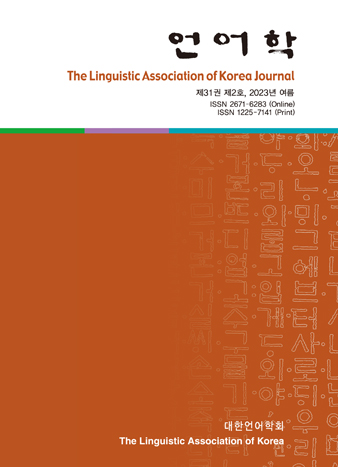대한언어학회 전자저널

31권 2호 (2023년 6월)
- Comparing Numeral Classifier Constructions in Japanese and Korean: The Role of Case Projection in Constituency Differences
-
Youngyoon Cho & Yongsuk Yoo
Pages : 45-61
Abstract
Cho, Youngyoon & Yoo, Yongsuk. Comparing numeral classifier constructions in Japanese and Korean: The role of case projection in constituency differences. The Linguistic Association of Korea Journal, 31(2), 45-61. This paper provides a comparative analysis of numeral classifier constructions in Japanese and Korean, focusing on the differences in constituency and the underlying syntactic structures. Through the examination of the base structures of NPs combined with conjunction and their total and separate interpretations, as proposed by Sudo (2015), we apply various constituency tests to investigate these phenomena. Our findings reveal key differences between the two languages, particularly in the role of Case Projection in determining constituency properties. This study contributes to the understanding of Japanese and Korean numeral classifier constructions and the broader field of comparative linguistics.
Keywords
# numeral classifier # case projection # comparative syntax # Korean and Japanese
References
- Bošković, Ž. (2013). Phases beyond clauses. In L. L.-S. Cheng & N. Corver (Eds.), Diagnosing syntax (pp. 13-28). Oxford University Press.
- Bošković, Ž. (2014). Now I’m a phase, now I’m not a phase: On the variability of phases with extraction and ellipsis. Linguistic Inquiry, 45(1), 27-89.
- Hagstrom, P. (1998). Decomposing questions. MIT Thesis (Ph.D.)
- Ishizuka, T. (2010). Alienable-Inalienable Asymmetry in Japanese and Korean Possession, 10
- Kim, C. (2005). Order and meaning: Numeral classifiers and specificity in Korean. In Proceedings of the 24th west coast conference on formal linguistics (pp. 218-226). Cascadilla Proceedings Project Somerville, MA.
- Kim, C.-K. (2010).The Numeral Quantifier and its Case in Korean. Studies in Humanities, 27, 31-50.
- Miyagawa, S. (2005). Locality in Syntax and Floated Numeral Quantifiers in Japanese and Korean. Proceedings of the 14th Japanese / Korean Linguistics Conference, CSLI, 10.
- Park, M. (2014) The syntax of 'slucing'/'fragmenting' in Korean: Evidence from the copula -i- 'be'*. Linguistic Research, 31(1), 113.
- Saito, M., & An, D. (2014). A Comparative Syntax of Ellipsis in Japanese and Korean. Japanese Syntax in Comparative Perspective, 1.
- Saito, M., Lin, J., & Murasugi, K. (1994). N'-Ellipsis and the Structure of Noun Phrases in Chinese and Japanese. Journal of East Asian Linguistics, 17(3), 302.
- Sakamoto, Y., & Yoo, Y. (2016). Different Constituency of Classifier Constructions in Japanese and Korean. 40th Annual Meeting of the Penn Linguistics Colloquium.
- Seo, J. M. (2007). 한국어의 문장 구조. 역락.
- Shibata, Y. (2014). A phonological approach to particle stranding ellipsis in Japanese. Poster presented at Formal Approaches to Japanese Linguistics (FAJL) 7. National Institute for Japanese Language and Linguistics and International Christian University.
- Sudo, Y. (2015). On the semantics of Phi features on pronouns. Ph.D. Dissertation, Massachusetts Institute of Technology.
- Takahashi, D. (2011). The hidden side of clausal complementation: Japanese/Korean nominalizers, phases, and the EPP. Journal of East Asian Linguistics, 20(4), 291-332.
- Yamashita, H. (2019). Reconsidering the Nature of Particle Stranding Ellipsis in Japanese. ICU Working Papers in Linguistics (ICUWPL) = ICU Working Papers in Linguistics(ICUWPL) 7(2019), 84.